Your cart is currently empty!
No parent wants to see their child in pain. But what can you do when your child develops a chronic pain condition and other treatments just don’t work? If you haven’t considered using Chinese herbs for juvenile arthritis, you may have found your new solution.
Childhood pain conditions have been treated successfully with Traditional Chinese medicine practices like acupuncture and herbal medicine for thousands of years. Today, we can still help our little ones live healthy, happy, pain-free lives with the help of these holistic practices.
Read on to learn more about how TCM works for juvenile arthritis and the best child-safe Chinese herbs for pain relief.
What is Juvenile Arthritis?
Juvenile arthritis (JA), also known as pediatric arthritis or childhood arthritis, is a chronic autoimmune disease that affects children and adolescents under the age of 16. Like adult-onset arthritis, JA is a condition with inflammation in the joints, leading to pain, swelling, and stiffness, and can potentially cause long-term tissue damage.
But, not all JA is the same. There are several different types of arthritis that can affect children:
- Oligoarticular Juvenile Arthritis
This is the most common type of juvenile arthritis and affects fewer than five joints in the body (olig– means “few”). Most children feel pain in their knees, wrists, and/or ankles. This version typically starts in children under the age of six.
- Polyarticular Juvenile Arthritis
Polyarticular JA affects five or more joints (poly– means “many”) and is sometimes related to rheumatoid arthritis. It often begins in the small joints of the hands and feet and may lead to systemic symptoms like fatigue and fever.
- Systemic Juvenile Arthritis
This type of JA affects the entire body, causing a full-blown inflammatory reaction. Children can experience symptoms such as high fever, skin rashes, and inflammation of internal organs. Joint pain is still a key symptom, but the systemic symptoms are often more prominent.
- Enthesitis-Related Arthritis
Enthesitis-related arthritis primarily affects the areas where tendons and ligaments attach to bones, commonly in the spine, hips, and knees. It is often associated with inflammatory bowel disease and has a strong genetic component.
- Psoriatic Juvenile Arthritis
Psoriatic JA is an autoimmune response that causes joint pain along with psoriasis – a skin condition marked by red, scaly patches and sometimes changes in the nails.
What Causes Juvenile Arthritis?
Unfortunately, scientists don’t know exactly what causes childhood arthritis. But, it is most likely related to inflammation and imbalances in the immune system.
Some children may also have a genetic predisposition to the disease, or have other factors (such as frequent infections or stress) that can trigger the autoimmune response and lead to inflammation in the joints.
Although it’s not a direct cause, lifestyle factors like diet and physical activity can also influence the severity and progression of juvenile arthritis.
Symptoms of Juvenile Arthritis
Juvenile arthritis (JA) can manifest in various ways, and the symptoms experienced by children with JA may vary depending on the type of arthritis and their general health condition. Here is a list of common symptoms associated with juvenile arthritis:
- Persistent joint pain in one or more joints
- Swollen and inflamed joints, or joints that are warm to the touch
- Stiffness or limping (especially in the morning or after exercise)
- Difficulty fully extending or flexing their joints
- Fatigue and a general sense of tiredness
- Difficulty doing basic activities (like dressing, hygiene, and even playing)
- Fever or rash (in children with systemic juvenile arthritis)
- Eye inflammation, redness, pain, or sensitivity to light
- Weight loss, reduced appetite, or growth delays
- Emotional or behavioral changes (such as anxiety or depression)
The Western Approach: Conventional Treatments for Juvenile Arthritis
Most Western treatment approaches focus on helping the child feel better as soon as possible. The core aims of treatment are to alleviate pain, reduce inflammation, slow disease progression, and enhance a child’s overall quality of life.
Conventional Treatments for Juvenile Arthritis
- Nonsteroidal Anti-Inflammatory Drugs (NSAIDs)
NSAIDs, like ibuprofen and naproxen, are often given to children to reduce their pain and keep inflammation low. They work by inhibiting specific enzymes responsible for inflammation.
- Disease-modifying antirheumatic Drugs (DMARDs)
DMARDs, such as methotrexate, slow the progression of rheumatoid-positive juvenile arthritis by moderating the immune system and reducing inflammation.
- Biologic Response Modifiers (Biologics)
Biologics, including drugs called TNF inhibitors, target specific immune system proteins to control inflammation.
- Corticosteroids
Corticosteroids, like prednisone, are potent anti-inflammatory medications used during severe flares of juvenile arthritis.
- Physical and Occupational Therapy
These therapies aim to maintain and improve joint function, mobility, and overall well-being. They have no significant side effects and are an important part of managing juvenile arthritis.
- Lifestyle Modifications
Making lifestyle changes like maintaining a balanced diet, engaging in regular exercise, and ensuring adequate rest can help manage symptoms and enhance overall health. These modifications generally have no adverse side effects and are encouraged as part of holistic treatment.
While these treatments are helpful in the short term, they can have side effects when used for long periods of time. Issues like weight gain, growth delays in children, bone thinning, liver problems, infections, and mood changes have been reported.
Chinese herbal medicine offers a sustainable, natural approach to managing juvenile arthritis symptoms without these side effects. Let’s learn more about how you can help your child feel better with the power of Chinese medicine.
The Eastern Approach: TCM Treatments for Juvenile Arthritis
Like Western medicine, Traditional Chinese Medicine works to relieve pain and other arthritis symptoms so children can live a healthier, happier life. But unlike conventional treatments, TCM goes one step further. In addition to symptom management TCM treatments also work to rebalance the root issues that lead to the development of arthritis in the first place.
In fact, by addressing the root imbalances contributing to your child’s juvenile arthritis, TCM can help ease their symptoms and, in some cases, reduce the need for high doses of medications or other treatments.
So, how can TCM address the root cause when other treatments (like medications) do not?
TCM takes into account all factors of a child’s life, including physical symptoms, emotional well-being, diet, lifestyle, and environmental influences. TCM also offers individualized treatments, taking into consideration their specific symptoms, body constitution, and the underlying TCM patterns of imbalance. This personalized approach ensures that the treatment plan is tailored to each child’s needs and helps them get healthy faster and with fewer setbacks.
TCM Diagnosis of Juvenile Arthritis: Patterns of Imbalance
For children with juvenile arthritis, TCM uses certain patterns of imbalance to guide the treatment and balance the body’s energy. While JA can be complex, there are a few key patterns that show up commonly in most children with arthritis:
- Wind-Cold-Damp Bi Syndrome
Bi syndrome is a unique phenomenon in TCM that describes joint pain and discomfort, often attributed to external factors like cold, wind, and dampness affecting the body. Many different types of arthritis fall under this pattern of imbalance, including some types of JA. Children with this pattern often experience joint pain and stiffness that gets worse in cold and damp weather.
- Blood Stasis
In this pattern, children may have severe joint pain, noticeable joint swelling, and limited range of motion. Their joints might feel heavy, and it can be challenging to move them freely.
- Kidney Deficiency
Children with kidney deficiency tend to get sick often, have weaker bones and joints, and may have growth issues. They might be more prone to developing arthritis, and their musculoskeletal development could be slower than other children.
- Liver Imbalance
A Liver imbalance is typically associated with emotional stress and mood swings, along with symptoms of inflammatory joint discomfort. When children with this pattern feel upset or stressed, their joint pain may worsen.
These patterns tend to be the most common underlying issues involved in JA, but every child is different! Your child may have signs of more than one pattern, or symptoms that don’t seem to match any. That’s where referring to a TCM practitioner to fine-tune your child’s diagnosis and treatment is essential.
Let’s dive into what those potential treatment plans can look like.
TCM Treatments for Juvenile Arthritis
- Acupuncture
Acupuncture is often a go-to therapy for those with stubborn pain conditions like arthritis. For children with juvenile arthritis, acupuncture can help alleviate joint pain, reduce inflammation, and enhance overall energy flow. It promotes a sense of balance and relaxation while addressing the root causes of the condition.
- Chinese Herbal Medicine
Chinese herbal medicine is also used to restore balance in the body from within. Certain herbs are used to combat pain, others may be used to quell inflammation, and others may be used to relieve stress and support healing. Here are some of the top herbs commonly used in the treatment of juvenile arthritis:- Boswellia (Ru Xiang)
Boswellia extracts may help reduce joint swelling and alleviate pain. - Turmeric (Jiang Huang)
Curcumin, a compound found in turmeric, is recognized for its anti-inflammatory properties. - Ginger (Gan Jiang)
Ginger can help with pain relief, enhance blood circulation, and reduce inflammation. - Licorice Root (Gan Cao)
Licorice root is used to harmonize and balance other herbs in formulas and can help reduce inflammation.
- Boswellia (Ru Xiang)
- Pediatric Tui Na
Tuina is a type of Chinese medical massage that is a great treatment for children. Because it is gentle and doesn’t involve needles, it can be an alternative to acupuncture. This massage helps to improve joint mobility, relieve pain, improve circulation, and calm the mind.
- Dietary Therapy
In TCM, diet plays a huge role in healing. As research reveals the power of gut health, it’s no surprise that what our children eat can be used as a form of medicine. Children with juvenile arthritis can benefit from reducing foods that are “dampening” or inflammatory, such as processed and sugary foods and dairy, while also increasing anti-inflammatory foods like fruits, vegetables, and fish rich in omega-3 fatty acids.
The Best Chinese Herbs for Juvenile Arthritis
Many of the same Chinese herbal formulas used for adult arthritis can be used to help children’s joint pain. Let’s take a look at some of the key formulas to help children restore balance and protect their joints.
Chinese Herbs for Juvenile Arthritis
For Wind-Cold-Damp Type Arthritis: Du Huo Ji Shen Wan
Du Huo Ji Sheng Wan is a classic formula that is commonly prescribed for arthritis. This formula is warming and moving – the perfect balance for a wind-cold-damp type of pain. If your child complains of stiffness and discomfort, particularly in cold, rainy, or damp weather, this formula may help.
For Hot-Type Rheumatoid-Positive Juvenile Arthritis: Si Miao Wan
For some children, their arthritis is caused by an overactive immune response to their own joint tissue. This is rheumatoid-positive arthritis and tends to show up with redness, swelling, and sometimes fever. In this case, Si Miao Wan is a better choice. This formula uses anti-inflammatory and cooling herbs to restore balance to the body and regulate the immune system.
For Blood Stasis Juvenile Arthritis: Xiao Huo Luo Dan
Extremely painful joints, stiffness, immobility, and exhaustion can be a sign that your child is suffering from a blood stasis type of arthritis. Xiao Huo Luo Dan is a formula designed to break through stasis and restore healthy blood flow to relieve pain. It can be used for general pediatric arthritis or rheumatoid-positive juvenile arthritis.
Chinese Tea for Juvenile Arthritis
For Easy Relief: Triple Joint Relief Tea
For children who struggle swallowing pills or don’t like to take capsules, a pain-relieving tea can be a great way to support their healing. Triple Joint Relief Tea is a gentle Chinese herbal tea formula that contains joint pain-fighting herbal ingredients. It also helps calm inflammation and increase healthy circulation. Children can drink this tea as-is, or brew a cup and mix it with a healthy juice they like (a no-sugar-added apple juice would work well).
Chinese Topical Liniment for Juvenile Arthritis
-
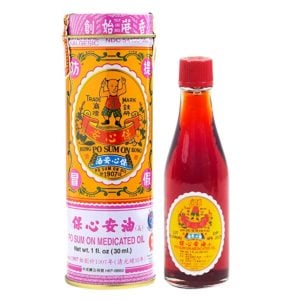 Po Sum On – External Analgesic – Pain Reliever
Starting at $5.99
Add to CartSelect options
This product has multiple variants. The options may be chosen on the product page
Po Sum On – External Analgesic – Pain Reliever
Starting at $5.99
Add to CartSelect options
This product has multiple variants. The options may be chosen on the product page
For Pain Relief at the Site: Po Sum On
To stop aching joints, try a gentle massage with Po Sum On. This liniment promotes relaxation, pain relief, and comfort for both adults and children alike. Plus, children tend to love the cinnamon-like smell and warming sensation. If your child has hot-type arthritis (red, swollen, warm-to-the-touch joints), use cooling White Flower Oil instead.
Dosing Chinese Herbs for Children
Many Chinese herbal formulas are safe for children when they’re given the proper formula and the proper dose. Just like children need a smaller dose of over-the-counter medicines, they also need a smaller amount of TCM medicines. While it’s best to work with a TCM practitioner to determine your child’s optimal dosage, the chart below can help you get started:
| Age | Recommended Daily Dose |
| 2-4 years | ¼ – ⅓ of adult dose |
| 4-6 years | ⅓ – ⅖ of adult dose |
| 6-9 years | ⅖ – ½ of adult dose |
| 9-14 years | ½ – ⅔ of adult dose |
| 14-18 years | ⅔ – full adult dose |
Chinese Herbs for Juvenile Arthritis: What Does the Research Say?
While most research studies focus on the benefits of Chinese herbs for adults with arthritis, there are few studies on TCM for children. Still, we can learn from the general research to better understand how Chinese herbs could help your child live free from pain.
- Chinese herbs have been shown to reduce inflammation.
Chinese herbs are well-known for their anti-inflammatory effects and may help reduce tissue damage in the joints, moderate the immune response, and relieve pain in little ones with arthritis. - Chinese herbs have been shown to reduce the damaging effects of arthritis.
Research on the formula Si Miao Wan (Si Miao Feng) revealed that taking the formula could prevent the breakdown of collagen in the joints and slow the progression of osteoarthritis. It also showed potent anti-inflammatory benefits.
Help Your Child Overcome Arthritis Pain with Chinese Herbs
Juvenile arthritis is a complicated and often heartbreaking condition for both children and their parents. Thankfully, with the support of both cutting-edge treatments and Chinese medicine, you can help your child get relief and be a kid again. Ready to find a natural solution for your child’s pain? Shop these and other holistic formulas for pain and arthritis today!
Share This
Table of Contents
- What is Juvenile Arthritis?
- The Western Approach: Conventional Treatments for Juvenile Arthritis
- The Eastern Approach: TCM Treatments for Juvenile Arthritis
- The Best Chinese Herbs for Juvenile Arthritis
- Dosing Chinese Herbs for Children
- Chinese Herbs for Juvenile Arthritis: What Does the Research Say?
- Help Your Child Overcome Arthritis Pain with Chinese Herbs
About the Author
Blog Categories
- Adaptogen Articles (8)
- Brain Health Articles (9)
- Chinese Medicine Basics Articles (13)
- Chinese Medicine for Pain Articles (15)
- Chinese Medicine for Pets Articles (3)
- Chinese Medicine for Skin Conditions Articles (6)
- Chinese Medicine Formula Articles (6)
- Chinese Medicine Sleep Articles (4)
- Conditions & Concerns Articles (24)
- Digestive Issues (5)
- Eating for the Seasons (2)
- Health & Lifestyle Articles (17)
- Heart Health Articles (4)
- In the News (1)
- Medicinal Mushrooms Articles (7)
- Men's Health Articles (8)
- Scholarships (5)
- Uncategorized Articles (9)
- Weight Loss, Diet & Obesity Articles (5)
- Women's Health Articles (10)
Articles Related To Best Chinese Herbs for Juvenile Arthritis
-
We’ve all had a headache before. While some are mercifully mild and short-lived, others can completely debilitate you for hours or even days. For most of us, headaches are just an occasional inconvenience. But for the over 39 million Americans who suffer from more severe migraines, they can be a major struggle that interferes with…
-
Whether it’s a nagging muscle ache, a fresh bruise, or persistent joint pain, these everyday aches can make even the simplest tasks feel like a mountain of a challenge. But before you reach for the OTC pain killers, your best solution may lie in an ancient natural concoction: Dit Da Jow. For centuries, people have…
-
When stubborn pain keeps you from doing what you love, a Chinese pain patch may be just what you need to get moving again. While herbal teas and pills are the most recognizable form of Chinese herbal medicine, there are many topical applications of herbal medicine as well. Topical herbal medicine (in the form of…
-
Joint pain can be a huge burden, especially as we age. One of the most common issues people face as they approach their 50s is what some TCM practitioners call “fifty-year-old-shoulder.” Also known as frozen shoulder or impingement syndrome, this shoulder pain can be extremely aggravating and keep you from doing the tasks and activities…
-
Summertime is here – and it’s the prime season for outdoor activities. Whether you’re exercising outside, playing sports, or just enjoying some time in the sun with friends and family, enjoying the summer and staying active also helps you maintain your best health. But, all that extra exercise can come at a cost. Increased activity…


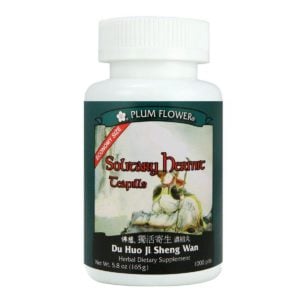 Plum Flower – Solitary Hermit Teapills (Du Huo Ji Sheng Wan)
Plum Flower – Solitary Hermit Teapills (Du Huo Ji Sheng Wan)
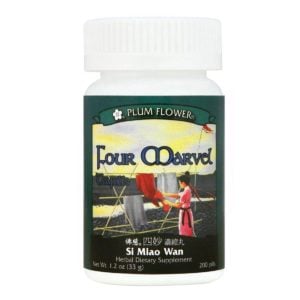 Plum Flower – Four Marvel (Si Miao Wan)
Plum Flower – Four Marvel (Si Miao Wan)
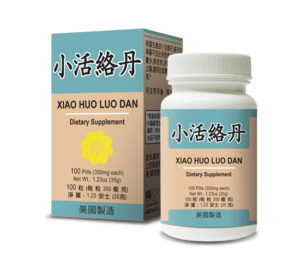 Xiao Huo Luo Dan (Healthy Joint Combo) – by Lao Wei
Xiao Huo Luo Dan (Healthy Joint Combo) – by Lao Wei
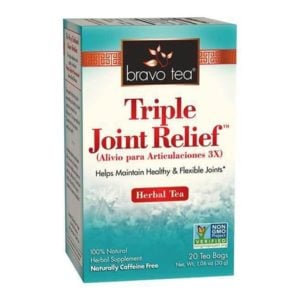 Triple Joint Relief Tea – by Bravo Tea
Triple Joint Relief Tea – by Bravo Tea